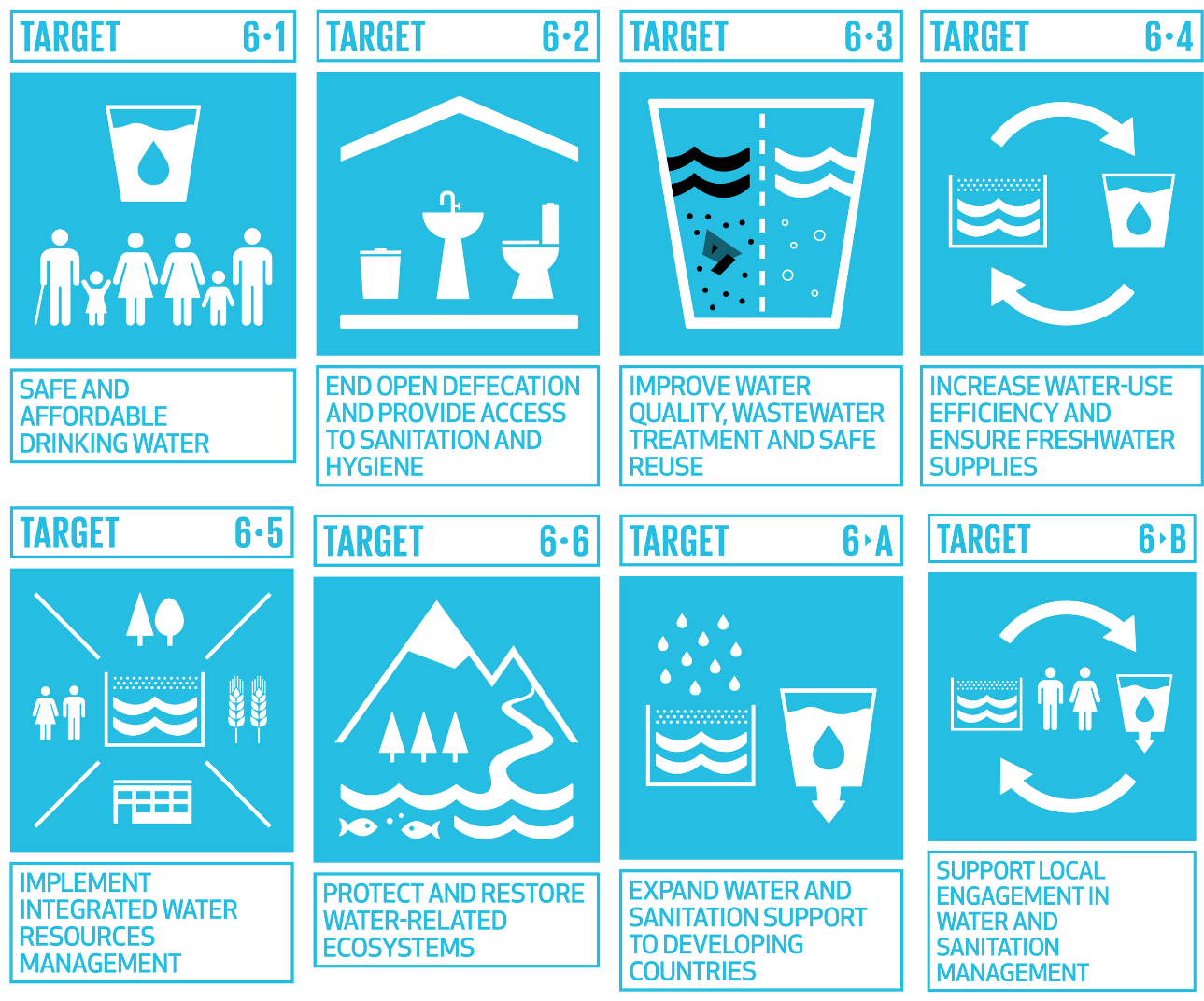SDG 6 - Ensure availability and sustainable management of water and sanitation for all
Actions for SDG 6
Analyze and control the quality and quantity of water and its source ⬇
- Be aware of the regulations set by authorities regarding water pollutants
- Work to identify possible sources of pollution in your waters
- Learn about the origin (where it comes from) of the water we consume before purchasing it
- Use water management and maintenance programs in your swimming pools (if applicable)
- Conduct regular reporting on water quantity and quality
Calculate your water footprint and implement programs for water efficiency ⬇
- Prioritize water efficiency across operations by installing best practice technologies for water conservation, in particular in water scarce areas
- Reuse pre-treated wastewater for sanitary and street cleaning
- Document your organization's water footprint
- Integrate gray water back into building operations, reducing the amount of potable water needed to flush toilets
- Use eco-friendly taps in our facilities
- Use a system for monitoring and developing specific indicators to monitor the evolution of consumption with respect to the objectives set
- Use water meters in your facilities
Conduct awareness and training campaigns on efficient use of water ⬇
- Educating employees about the importance of water efficiency, including tying performance bonuses or operations-based incentives to efficient practices
- Educate consumers about appropriate water behaviors, explaining global water quality and scarcity issues, thus attempting to shift the negative implications of the use phase associated with many consumer products
- Collaborate with NGOs that encourage and help clean water for all
- Display posters for responsible water use in your facilities
- Provide incentives for employees and/or customers to use less water
- Conduct or participate in workshops demonstrating the importance of efficient water use
Implement company policies and action plans to eliminate water pollution ⬇
- Mitigating against water pollution with state-of-the-art wastewater treatment processes for effluent discharge
- Have protocols and means to avoid water pollution
- Reduce the use of toxic substances, plastics and non-biodegradable materials
- Have a wastewater treatment plan to ensure the safe discharge of potentially contaminated water
- Reduce the likelihood of groundwater contamination by treating and processing all waste with exceptional precaution, according to local and federal guidelines
- Install dosing and regulation systems in swimming pools
- Development of innovative manufacturing processes such that substances with high water contamination potential are eliminated and substituted with materials that are easier to remove from water systems
Capture, recycle and reuse water, prorating the protection of ecosystems ⬇
- Install water collection tanks for reuse
- Install filters in water collection tanks to make it suitable for consumption
- Offer employees and customers un-bottled water
- Buy products that require minimal water expenditure for their processing
- Subcontract sustainable water managers to ensure reducing consumption
- Invest in water and sanitation projects or infrastructure in under-served regions
- Invest in clean-ups and restoration of water ecosystems to ensure sustainable water withdrawals
SDG 6 in Canada
Challenges in Canada for water quality and sanitation ⬇
- Indigenous communities across Canada continue to experience health problems caused by poor water and sanitation
- A key component of the Government of Canada’s commitment to close the socio-economic gaps that exist between Indigenous and most nonIndigenous peoples in Canada is to address the challenges of access to clean water and sanitation in communities.
There are many investments and programming across fedearl departments and agencies that support the implementation of SDG6 ⬇
- The $180-billion Investing in Canada Plan provides support for infrastructure solutions including treating water and wastewater, managing storm water and mitigating the impacts of flooding and other risks.
- The Plan’s Green Infrastructure investment stream assists with building capacity to treat and manage water, wastewater and storm water, accessing potable water and reducing or remediating soil and air pollution throughout Canada
- As part of Canada’s international assistance efforts, International Development Research Centre (IDRC) has invested more than $100 million over three decades to support research on water and water-related issues such as poverty reduction, improving health and sanitation, and increasing local governments’ ability to provide sustainable services to citizens
- The Centre for Affordable Water and Sanitation Technology (CAWST) helps people all over the world get safe drinking water and adequate sanitation in their own homes by providing capacity development services to complement technology infrastructure. Recognizing that women can be powerful agents of change, CAWST puts women at the centre of poverty alleviation by empowering them with the knowledge and skills to provide water, sanitation and hygiene (WASH) services in their homes and communities. CAWST helps empower women to become WASH technicians, entrepreneurs and community leaders.

Latest Updates/Resources related to SDG 6
Sources
Government of Canada, Canada’s Implementation of the 2030 Agenda for Sustainable Development - Voluntary National Review, 2018
SDG Compass, Learn More About the SDGs, 2015





